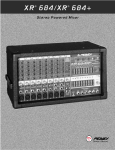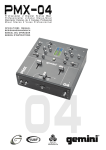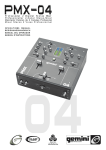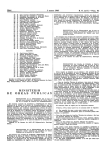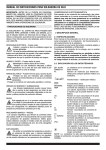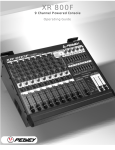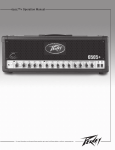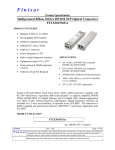Download Peavey EVH 5150 II User's Manual
Transcript
Operating Guide Intended to alert the user to the presence of uninsulated “dangerous voltage” within the product’s enclosure that may be of sufficient magnitude to constitute a risk of electric shock to persons. Intended to alert the user of the presence of important operating and maintenance (servicing) instructions in the literature accompanying the product. CAUTION: Risk of electrical shock — DO NOT OPEN! CAUTION: To reduce the risk of electric shock, do not remove cover. No user serviceable parts inside. Refer servicing to qualified service personnel. WARNING: To prevent electrical shock or fire hazard, do not expose this appliance to rain or moisture. Before using this appliance, read the operating guide for further warnings. Este símbolo tiene el propósito, de alertar al usuario de la presencia de “(voltaje) peligroso” sin aislamiento dentro de la caja del producto y que puede tener una magnitud suficiente como para constituir riesgo de descarga eléctrica. Este símbolo tiene el propósito de alertar al usario de la presencia de instruccones importantes sobre la operación y mantenimiento en la información que viene con el producto. PRECAUCION: Riesgo de descarga eléctrica ¡NO ABRIR! PRECAUCION: Para disminuír el riesgo de descarga eléctrica, no abra la cubierta. No hay piezas útiles dentro. Deje todo mantenimiento en manos del personal técnico cualificado. ADVERTENCIA: Para evitar descargas eléctricas o peligro de incendio, no deje expuesto a la lluvia o humedad este aparato Antes de usar este aparato, Iea más advertencias en la guía de operación. Ce symbole est utilisé dans ce manuel pour indiquer à l’utilisateur la présence d’une tension dangereuse pouvant être d’amplitude suffisante pour constituer un risque de choc électrique. Ce symbole est utilisé dans ce manuel pour indiquer à l’utilisateur qu’il ou qu’elle trouvera d’importantes instructions concernant l’utilisation et l’entretien de l’appareil dans le paragraphe signalé. ATTENTION: Risques de choc électrique — NE PAS OUVRIR! ATTENTION: Afin de réduire le risque de choc électrique, ne pas enlever le couvercle. Il ne se trouve à l’intérieur aucune pièce pouvant être reparée par l’utilisateur. Confiez I’entretien et la réparation de l’appareil à un réparateur Peavey agréé. AVERTISSEMENT: Afin de prévenir les risques de décharge électrique ou de feu, n’exposez pas cet appareil à la pluie ou à l’humidité. Avant d’utiliser cet appareil, lisez attentivement les avertissements supplémentaires de ce manuel. Dieses Symbol soll den Anwender vor unisolierten gefährlichen Spannungen innerhalb des Gehäuses warnen, die von Ausreichender Stärke sind, um einen elektrischen Schlag verursachen zu können. Dieses Symbol soll den Benutzer auf wichtige Instruktionen in der Bedienungsanleitung aufmerksam machen, die Handhabung und Wartung des Produkts betreffen. VORSICHT: Risiko — Elektrischer Schlag! Nicht öffnen! VORSICHT: Um das Risiko eines elektrischen Schlages zu vermeiden, nicht die Abdeckung enfernen. Es befinden sich keine Teile darin, die vom Anwender repariert werden könnten. Reparaturen nur von qualifiziertem Fachpersonal durchführen lassen. ACHTUNG: Um einen elektrischen Schlag oder Feuergefahr zu vermeiden, sollte dieses Gerät nicht dem Regen oder Feuchtigkeit ausgesetzt werden. Vor Inbetriebnahme unbedingt die Bedienungsanleitung lesen. 2 ENGLISH 5150® II Tube Guitar Amplifier Congratulations on your purchase of the all new 5150® II. Peavey’s continuous design collaboration with guitar icon and legend, Edward Van Halen, has produced yet another feature-packed, monster guitar head. Like the original 5150 head, the 5150 II offers two channels. However, the 5150 II adds separate EQ, Resonance, and Presence controls to each channel, giving you more control and flexibility. The new footswitch provides foot control of channel selection, effects loop, and the newly added ability to select the Crunch feature. Now you can instantly obtain that extra gain in the Rhythm Channel with your foot and never have to take your hand off the guitar. Finally, the Clean Channel has been added, completely redesigned to sound much cleaner, and has one 12AX7 devoted to just the Clean/Crunch. The following guide explains these features and how to operate each one in order to obtain your desired sound. We recommend that you read this manual carefully, paying close attention to any warnings or cautions. FEATURES: • Two distinct tube channels with footswitch control • LED “active” indicators for each channel • Bright switch for Rhythm channel • Crunch switch on Rhythm channel with footswitch control • Separate equalizer sections for each channel • Separate power amp controls (Resonance and Presence) for each channel • Separate preamp controls (Pre and Post Gain) for each channel • Standby power switch • Bias test points on rear panel • Effects loop with footswitch control • 1/4" Preamp output jack • Speaker impedance selection switch (4, 8, 16 ohm) • Two parallel 1/4" speaker output jacks • 120 watts output power ohm output power • Metal three button footswitch with detachable 25' cable 5150® is a registered trademark of Edward Van Halen. 3 REAR PANEL FEATURES 2 1 3 10 7 8 9 6 4 5 POWER (1) LINE CORD: This line cord provides the AC power to the unit. Connect the line cord to a properly grounded AC supply. Damage to the equipment may occur if improper line voltage is used. (See voltage marking on unit.) Never remove or cut the ground pin of the line cord plug. NOTE: FOR UK ONLY As the colors of the wires in the mains lead of this apparatus may not correspond with the colored markings identifying the terminals in your plug, proceed as follows: (1) The wire which is colored green and yellow must be connected to the terminal which is marked by the letter E, or by the earth symbol, or colored green or green and yellow. (2) The wire which is colored blue must be connected to the terminal which is marked with the letter N, or the color black. (3) The wire which is colored brown must be connected to the terminal which is marked with the letter L or the color red. (2) FUSE WARNING: THE FUSE SHOULD ONLY BE REPLACED WHEN THE POWER CORD HAS BEEN DISCONNECTED FROM ITS POWER SOURCE. A 5 amp fuse is located within the cap of the fuse holder. It must be replaced with the same type and value in order to avoid damage to the equipment and to prevent voiding the warranty. If the amp repeatedly blows fuses, it should be taken to a qualified service center for repair. (3) GROUND SWITCH This is a three-position, rocker type switch which, for most applications, should be operated in the center (zero) position. If hum or noise is noticed coming from the speaker enclosure(s) with the Ground Switch in the center position, place the Ground Switch to positive (+) or negative (-) to minimize hum. Should a hum/noise problem continue, consult your authorized Peavey dealer, the Peavey factory, or a qualified service technician. NOTE: THE GROUND SWITCH IS NOT FUNCTIONAL ON 220/240 VOLT MODELS. INs AND OUTs (4) SPEAKER JACKS These jacks are provided for the connection of speaker enclosure(s). The minimum speaker impedance is 4 ohms. The Impedance Selector Switch (5) should be set accordingly. (5) IMPEDANCE SELECTOR SWITCH (5) Use this switch to select the appropriate impedance of the speaker enclosure(s) connected to the Speaker Jacks (4). If two enclosures of equal impedance are used, the switch should be set at one half of that value (e.g., two 16 ohm enclosures: set switch to 8 ohms; two 8 ohm enclosures: set switch to 4 ohms). 4 (6) REMOTE FOOTSWITCH JACK This jack is provided for the connection of the supplied remote footswitch. The footswitch cable should be plugged in before the amp is powered up. When the footswitch is plugged into the Remote Footswitch Jack, the Channel Select switch (14) must be pressed to the “in” position for remote selection of the Lead or Rhythm channel (right footswitch button). The On and Off operation of Effects (left footswitch button) will work at all times. Remote selection of Crunch gain boost (center footswitch button) is available only when the Crunch Switch (22) is selected. See page 9 for detailed Footswitch diagram. (7/8) EFFECTS SEND/EFFECTS RETURN Signals are supplied to outboard effects or signal processing units by patching from the Effects Send (7) output into the outboard unit(s) and back into the Effects Return (8) input using shielded cables with 1/4" mono phone plugs. Only non-gain effects devices (chorus, reverb, delay, etc.) should be used in the effects loop. If footswitch is used, “Effects” must be selected (LED illuminated) for effects to work. (9) PREAMP OUT This output can be used to send a preamp signal from the 5150 II to a mixing console, tape recorder, etc., using a shielded instrument cable. Patching from the PREAMP OUT does not affect the normal operation of the amplifier. BIAS ADJUST SYSTEM (10) BIAS TEST TERMINALS These terminals, along with the adjustment knob behind the grill are provided to measure and adjust the power amp tubes’ bias. The bias adjustment should only be done by a qualified technician. FRONT PANEL FEATURES 13 15 14 21 16 22 15 20 12 17 18 19 23 11 24 ON STANDBY (11) POWER SWITCH/LED This switch supplies power to the unit. Depressed to the “ON” position, the red Power LED indicator will illuminate above the Power Switch when power is being supplied to the unit. (12) STANDBY SWITCH/LED This switch allows the 5150 II to be placed in a non-operational standby mode. When the Standby Switch is activated, the tubes remain hot and ready for instantaneous operation, eliminating warm-up time. The Standby LED indicator above the switch will illuminate when the amp is in the operational mode. 5 PREAMP (13) INPUT The 5150 II input jack is designed to accommodate a variety of guitar output levels, regardless of pickup configuration. Due to the extreme high gain capabilities of the 5150 II, it is imperative that you use a premium shielded instrument cable in order to minimize noise. (14) CHANNEL SELECT SWITCH This switch allows selection of the Rhythm or Lead Channel. Depressing the switch to the “in” position activates the Lead Channel. The red LED next to the Lead Pre control will illuminate to indicate that the Lead Channel is active. In the “out” position, the Rhythm channel is activated and the green LED illuminates next to the Rhythm Pre control to indicate that the Rhythm Channel is active. Channels may be remotely selected using the 5150 II’s footswitch. If remote selection is desired, the Channel Select Switch must be set to the “in” position (Lead Channel). See page 9. (15) CHANNEL SELECT LED Both the Rhythm Channel and Lead Channel have these LEDs to indicate which channel is active. The two Channel Select LEDs are never on at the same time. The channel with its indicator illuminated is the active channel. (16/20) PRE and POST GAIN The channel Pre (16) and Post (20) Gain controls operate in the same manner for both channels. However, the Lead channel does have more pregain than the Rhythm Channel. In most applications, the Rhythm channel should be set up with the Pre Gain at the lower “cleaner” settings (0-4) and the Post Gain should be set for overall volume. The Rhythm channel can be converted to a medium distortion channel by activating the Crunch switch (22). This will more closely match the pre gain of the two channels. The Lead channel should be set up with the Pre Gain at the mid to upper settings (5-10) and the Post Gain should be set for overall volume. (17/18/19) EQUALIZATION The 5150 II’s equalization block features passive low, mid, and high EQ that is custom tailored for each channel to Edward Van Halen’s specifications. Adjusting the control(s) counterclockwise will result in an attenuation of the signal within the frequency band. (21) BRIGHT SWITCH Activates a preset boost in the treble frequencies (6 dB at 2 kHz) and affects only the Rhythm Channel. (22) CRUNCH SELECT SWITCH Boosts the gain of the Rhythm channel to create a medium distortion or in between tone. Depress to the “in” position to activate. (23/24) RESONANCE / PRESENCE Unique to Peavey instrument amplifiers, the Resonance control (23) can be set to boost the gain of the power amp in the low frequencies at the resonance/attenuation point of the speaker cabinet. In simple terms, the Resonance control works like a low EQ to offset lowend frequency drop out. The Presence control (24) works in the same manner, boosting the high frequencies. Experimentation using your particular speaker cabinet, along with personal taste, will determine your setting for these important controls. 6 5150® II SPECIFICATIONS PREAMP SECTION POWER AMPLIFICATION SECTION EFFECTS RETURN: Impedance: Very High Z, 470 k ohms Designed Level: -10 dBV, 300 mV RMS The following specs are measured @ 1 kHz with the controls preset as follows: Low and High EQ @ 10 Mid EQ @ 0 Bright out Lead and Rhythm Posts @ 10 Presence and Resonance @ 0 dB Nominal levels with Pre Gains @ 5 Minimum levels with Pre Gains @ 10 RATED POWER AND LOAD: 120 W RMS into 16, 8, or 4 ohms POWER @ CLIPPING: (Typically @ 5% THD, 1 kHz, 120 V AC line) 130 W RMS into 16, 8, or 4 ohms (Bias must be reduced to measure.) PREAMP OUT: Load Impedance: 47 k ohms or greater Nominal Output: +10 dBV, 3 V RMS REMOTE FOOTSWITCH: Special 3-button unit with LED indicators (supplied) Channel select and reverb PREAMP INPUT: FREQUENCY RESPONSE: Impedance: Very high Z, 470K ohms +0, -3 dB, 50 Hz to 20 kHz @ 100 W RMS into 8 ohms SYSTEM HUM AND NOISE @ NOMINAL LEVEL (clean channel): Lead Channel (with channel select in): Nominal Input Level: -60 dBV, 1 mV RMS Minimum Input Level: -76 dBV, .15 mV RMS HUM AND NOISE: Greater than 75 dB below rated power POWER AMP EQ: Active Presence: +10 dB @ 2 kHz Active Resonance: +10 dB @ cabinet resonant frequency (20 Hz to 20 kHz unweighted) Greater than 63 dB below rated power EQUALIZATION: Custom Low, Mid, and High passive type EQ Push Bright (Rhythm Channel only) +6 dB @ 2 kHz Push Crunch (Rhythm Channel only) Increases gain Clean Channel (with channel select out): Nominal Input Level: -30 dBV, 30 mV RMS Minimum Input Level: -34 dBV, 20 mV RMS Maximum Input Level: 0 dBV, 1.0 V RMS (Subtract 24 dB with Crunch switch in.) POWER CONSUMPTION (Domestic): 400 watts 50/60 Hz, 120 V AC (Domestic) TUBE COMPLEMENT: 6-12AX7 preamp tubes (1 for clean/crunch, 3 for Lead, 1 for EFX and 1 phase splitter 4-6L6GC DIMENSIONS (H x W x D): 10" x 26.625" x 11.75" (25.4 cm x 67.6 cm x 29.8 cm WEIGHT: EFFECTS SEND: 48.3 lbs. (21.91 kg) Load Impedance: 47 k ohms or greater Nominal Output: -10 dBV, 300 mV RMS Features and specifications subject to change without notice. 5150® II BLOCK DIAGRAM PRE LOW MID HI POST TUBE STAGES LEAD FOOTSWITCH EFFECTS TUBE STAGE SWITCH LOGIC SEND SWITCH LOGIC FOOTSWITCH INPUT TUBE BUFFER RETURN CHANNEL SELECT TUBE STAGES TUBE STAGES RHYTHM PRE LOW MID HI PUSH BRIGHT SPEAKER OUTPUTS POST PUSH CRUNCH TUBE POWER AMP IMPEDANCE SWITCH FOOTSWITCH SWITCH LOGIC PREAMP OUT SIGNAL FLOW BLOCK DIAGRAM RESONANCE PRESENCE LEAD 7 RESONANCE PRESENCE RHYTHM 5150® II HOOKUP DIAGRAM 16 Ohms 8 Ohms Set switch to 8 Ohms Set switch to 4 Ohms 16 Ohms 8 Ohms DeltaFex™ Rack Mount Effects Unit From EVH® 5150 II Effects Send Output to Input of Rack Effects Unit EVH® 5150 II Back Panel From Output of Rack Effects Unit to EVH® 5150 II Effects Return Input Delta Stomp™ Floor Pedal From EVH® 5150 II Effects Send Output to Input of Effects Pedal From Output of Effects Pedal to EVH® 5150 II Effects Return Input EVH® 5150 II Back Panel 8 5150® II RECOMMENDED SETTINGS Southern Rock/Country In In Set to proper volume Out Signature Setting In In In Set to proper volume Activates Effects Loop when switch is pressed and LED illuminates Activates Crunch Voicing on Rhythm when switch is pressed and LED illuminates *Selects (toggles) between Rhythm and Lead channels All switches are push on/push off. There are no momentary switches on the footswitch. *NOTE: Channel select switch (14) must be pressed to the “in” position for this switch to function. 9 ESPAÑOL Amplificador de bulbos para guitarra 5150® II Felicidades por tu compra del nuevo 5150® II. La colaboraci≤n cont¿nua de Peavey con el ¿dolo y leyenda de la guitarra, Edward VanHalen, ha producido un monstruoso cerebro para guitarra lleno de nuevas ventajas Como el cerebro 5150 original, el 5150 II ofrece dos canales. Sin embargo, el 5150 II a±ade controles de Ecualizaci≤n Separada, Resonancia, y Presencia a cada canal, dßndote mayor control y flexibilidad. El nuevo pedal ofrece control de pie de canales, “loop” de efectos, y la nuva abilidad de seleccionar la funci≤n de “crunch”. Ahora puedes obtener esa ganancia adicional en el canal de Ritmo con el pie, sin tener que quitar las manos de la guitarra nunca mßs. Finalmente, el canal limpio ha sido a±adido, redise±ado completamente para sonar mucho mßs limpio, y tiene un 12AX7 dedicado exclusivamente al limpio/crunch. La siguiente gu¿a explica estas caracter¿sticas y c≤mo operar cad una para lograr obtener tu sonido deseado. Te recomendamos leer el manual cuidadosamente, poniendo atenci≤n a las precauciones y avisos. CARACTER¿STCAS: • • • • • • • • • • • • • • • Dos canales distintivos con control de pedal Indicadores LED “activos” para cada canal Switch de brillantez para el canal de Ritmo (o acompa±amiento) Switch de crunch en el canal de Ritmo con control de pedal Secciones separadas de ecualizador para cada canal Controles de amplificador de poder (Resonancia y Poder) para cada canal Controles separados de preamp (Pre y Post Ganacia) pra cada canal Switch de poder “standby” Puntos de prueba de biaas en el panel trasero Loop de efectos con control de pedal Salida de Preamp de 1/4" Switch de selecci≤n de impedancia para las bocinas (4, 6, 8 ohmios) Dos salidas paralelas de 1/4" para bocina Salida de 120 wats de salida de poder en ohmios Pedal de tres botones con cable removible de 25' 5150® es una marca registrada de Edward Van Halen 10 CARACTER¿STICAS DEL PANEL TRASERO 2 1 3 10 7 8 9 6 4 5 PODER (1) CABLE DE L¿NEA: Est cable de linea provee el poder de CA a la unidad. Conecta el cable a un suministro de CA propiamente aterrizado. Da±o al equipo puede causarse si se usa un voltage de linea inapropiado. (Ver marcaci≤n de voltage en la unidad). Nunca quites el alfiler de tierra del conector del cable de l¿nea. NOTA S¿LO PARA EL REINO UNIDO Ya que el color de los cables de este aparato pueden no corresponder a las marcas de colores que identidfican las terminales en tu conector, haz lo siguiente: (1) El alambre verde y amarillo debe de conectarse a la terminal marcada con la letra E, o por el s¿mbolo de tierra, o del color verde o verde y amarillo. (2) El alambre azul debe ser conectado a la terminal marcada con la letra N , o de color negro. (3) El alambre caf¿ debe conectarse a la terminal marcada con la letra L o el color rojo. (2) FUSIBLE PRECAUCI¿N: EL FUSIBLE SOLAMENTE DEBE SER REEMPLAZADO CUANDO EL CABLE DE PODER HAY ASIDO DESCONECTADO DE SU FUENTE DE PODER. Un fusible ha sido colocado dentro de la tapa del compartimiento del fusible. Debe ser reemplazado con uno del mismo valor y tipo para evitar alg·n da±o al equipo y para no cancelar la garant¿a. Si el amplificador quema fusibles cont¿nuamente, debe ser llevado a un centro de servicio cali ficado para ser reparado. (3) SWITCH DE TIERRA Este es un switch de tres posiciones que, para la mayor¿a de las aplicaciones, se debe operar en la posici≤n central (cero). Si un zumbido o ruido saliera de la(s) bocina(s) con el Switch de Tierra en la posici≤n central, pasa el switch a la posici≤n (+) ≤ (-) para minimizar el zumbido. Si persiste este problema, consulta a un vendedor autorizado de Peavey, a la fßbrica misma, o a un t¿cnico de servicio calificado. NOTA: EL SWITCH DE TIERRA NO FUNCIONA EN LOS MODELOS DE 220/240 VOLTIOS. ENTRADAS Y SALIDAS (4) CONEXIONES PARA BOCINAS Estas conexiones sirven para conectar bocina a 5150 II. La m¿nima impedancia es 4 ohmios. El Switch Selector de Impedancia (5) debe ser ajustado de manera correspondiente. (5) SWITCH DE SELECTOR DE IMPEDANCIA Usa este switch para seleccionar la impedancia apropiada de la bocina o bocinas conectada a las conexiones para bocinas (4). Si dos gabinetes con la misma impedancia son usados, el 11 switch debe ser ajustado a la mitad de ese valor, por ejemplo: dos gabinetes de 16 ohmios: ajustar switch a 8 ohmios; dos gabinets de 8 ohmios: ajustar switch a 4 ohmios. (6) ENTRADA PARA PEDAL REMOTO Este pedal se proporciona para para la conexi≤n del pedal remoto inclu¿do. El cable del pedal debe ser conectado antes de que se prenda el ampli. Cuando es conectado el pedal su entrada, el Switch de Selecci≤n de Canal (14) se debe presionar para quedar oprimido para la selecci≤n remota del canal “Lead” o “Rhythm” (bot≤n derecho del pedal). La operci≤n de Encendido y Apagado de Efectos (bot≤n izquirdo del pedal) funcionarß en todo momento. La selecci≤n de la ganancia de “Crunch” (bot≤n central del pedal) s≤lo estß disponible cuando est¿ seleccionado el Switch de Crunch (22). Ver la pßgina 9 para un diagrama detallado del pedal. (7/8) ENV¿O Y RETORNO DE EFECTOS La se±ales son enviadas a unidades perif¿ricas de efectos al parchear la salida de Env¿o de Efectos (7) a las unidades perif¿ricas y de regreso a la entrada del Retorno de Efectos (8) usando cables blindados monof≤nicos con conectores de 1/4". S≤lo efectos sin ganancia (chorus, reverb, delay, etc.) deben ser usados en el “loop”. Si se usa el pedal, debe seleccionarse “Effects” (led iluminado) para que los efectos funcionen. (9) SALIDA DE PREAMP Esta salida puede ser usada para mandar una se±al de preamp del 5150 II a una consola, grabadora, etc., usando un cable brindado de instrumento. El parchear desde la SALIDA DE PREAMP no afecta la operaci≤n normal del amplificador. SISTEMA DE AJUSTE DE BIAS (10) TERMINALES DE PRUEBA DE BIAS Estas terminales, junto con la perilla de ajuste que se encuentra detrßs de la parrilla sirven para medir y ajustar el bias de los bulbos del amplificador de poder. El ajuste del bias s≤lo debe ser llevado a cabo por un t¿cnico calificado. CARACTER¿STICAS DEL PANEL FRONTAL 13 15 14 21 16 22 15 20 12 17 18 19 23 11 24 ON STANDBY (11) SWITCH/LED DE PODER Este switch le da poder a la unidad. Oprimido en la posici≤n “on”, el LED rojo de Poder se iluminarß arriba del Switch de Poder cuando la unidad sea suministrada con poder. (12) SWITCH/LED “STANDBY” Este switch permite que el 5150 II se coloque en un modo no operacional. Cuando se activa el switch de stanby, los bulbos permanecen calientes y listos para una operaci≤n 12 instantßnea, eliminando el tiempo de calientamiento. El indicador led de Standby arriba del switch se iluminarß cuando el ampli est¿ en modo operacional. PREAMPLIFICADOR (13) ENTRADA La entrada del 5150 II estß dise±ada para recibir una variedad de niveles de salida de guitarras, sin importar la configuraci≤n de las pastillas. Debido a la capacidad de ganancias extremadamente altas del 5150 II es imperativo que uses un cable blindado de instrumento de la mßs alta calidad para minimizar el ruido. (14) SWITCH DE SELECCI¿N DE CANAL Este switch permite la selecci≤n de los canales de acompa±amiento o l¿der. El switch en la posici≤ oprimida activa el canal l¿der. El LED rojo que estß junto al control “Lead Pre” se iluminarß para indicar que el canal l¿der estß activo. En la posici≤n no oprimida, el canal de acompa±amiento (rhythm) es activado y el LED verde se iluminarß junto al control “Rhythm Pre” para indicar su activaci≤n. Los canales pueden ser activados remotamente usando el pedal del 5150 II. Si se desea esta secci≤n remota, el Switch de Selecci≤n de Canal debe estar en la posici≤n oprimida (canal L¿der). Ver pßgina 9. (15) LED DE SELECCI¿N DE CANAL Tanto el canal de acompa±amiento com el l¿der, tienen estos LEDs para indicar qu¿ canal estß activo. Estos dos LEDs nunca estßn prendidos al mismo tiempo. (16/20) GANANCIA PRE Y POST Los controles de ganancia de los canales Pre (16) y Post (20) operan de la misma manera para ambos canales. Sin embargo, el canal l¿der s¿ tiene mßs pre ganancia que el canal de acompa±amiento. En la mayor¿a de las aplicaciones el canal de acompa±amiento debe de ajustarse con la pre ganancia a los valores mßs “limpios” (0-4) y la post ganancia debe ser ajustada para un volumen general. El canal de acomap±amiento puede ser convertido a una distorsi≤n mediana activando el switch Crunch (22). Esto igualarß mßs de cerca la pre ganancia de los dos canales. El canal l¿der debe ser ajustado con la pre ganancia en los valores medios a altos (5-10) y la post ganancia debe ser ajustada para un volumen general. (17/18/19) ECUALIZACI¿N El bloque de ecualizaci≤n del 5150 II presenta ecualizaci≤n de bajas medias y altas frecuancias que estß dise±ado espec¿ficamente para cada canal por Edward Van Halen. Si ajustas los controles en direcci≤n contraria a las manecillas del reloj, atenuarßs la se±aldentro de la banda de frecuencia. (21) SWITCH DE BRILLANTEZ Activa un aumento predeterminado en las frecuancias agudas (6 dB a 2 kHz) y afecta s≤lo al canal de acompa±amiento. (22) SWITCH DE SELECCI¿N DE CRUNCH Aumenta la ganancia del canal de acompa±amiento para crear una distorsi≤n media. Debe estar en la posici≤n oprimida para activarla. (23/24)RESONANCIA/PRESENCIA El control de resonancia (23) s≤lo se encuentra en los apmlificadores de instrumento de 13 Peavey. ¿ste se puede ajustar para aumentar la ganancia del amplificador de poder en las frecuencias bajas del punto de resonancia/atenuaci≤n del gabinete de bocina. En t¿rminos mßs sencillos, el control de resonancia funciona como un ecualizador de bajas frecuencias para evitar la p¿rdida de las mismas. El control de presencia (24) funciona de la misma manera, aumentando las frecuencias altas. La experimentaci≤n al usar tu propia bocina, aunada al gusto personal, determinarß tus valores para estos importantes controles. 5150« II ESPECIFICACIONES SECCI¿N DE AMPLIFICACI¿N DE PODER PODER Y CARGA CLASIFICADOS: 120 W RMS a 16, 8, ≤ 4 ohmios PODER @ SATURACI¿N: (T¿picamente @ 5% THD, 1 kHz, 120 V linea CA) 130 W RMS a16, 8, o 4 ohmios (Bias debe reducirse a la medida.) RESPUESTA DE FRECUENCIA : +0, -3 dB, 50 Hz a 20 kHz @ 100 W RMS a 8 ohmios ZUMBIDO Y RUIDO: Mßs que 75 dB menos que el poder clasificado Canal l¿der (con selector de canal oprimido): Nivel nominal de entrada : -60 dBV, 1 mV RMS Nivel m¿nimo de entrada: -76 dBV, 15 mV RMS Clean Channel (with channel select out): Canal limpio : -30 dBV, 30 mV RMS Nivel m¿nimo de entrada: -34 dBV, 20 mV RMS Nivel mßximo de entrada: 0 dBV, 1.0 V RMS (Restar 24 dB con Crunch activado) ENV¿O DE EFECTOS: Impedancia de carga: 47 k ohmios o mayor Salida Nominal: -10 dBV, 300 mV RMS RETORNO DE EFECTOS: Impedancia: Z Muy Alta, 470 k ohmios Nivel Dise±ado: -10 dBV, 300 mV RMS ECUALIZADOR DEL AMPLI DE PODER: Presencia activa: +10 dB @ 2 kHz Presencia activa: +10 dB @ gabinete frecuencia resonante CONSUMO DE PODER (Dom¿stico): 400 watts 50/60 Hz, 120 V CA (Dom¿stico) SALIDA DE PREAMP : Impedancia de carga: 47 k ohmios o mayor Salida Nominal: +10 dBV, 3 V RMS PEDAL REMOTO : Unit especial de tres votones con indicadores LED (inclu¿do) Selecci≤n de canal y reverb Complemento de bulbos: 6-12AX7 bulbos de preamp (1 para limpio/crunch, 3 para l¿der, 1 para EFX y 1 “splitter” de fase 4-6L6GC SECCI¿N DE PREAMPLI Las especificaciones siguientes se miden @ 1 kHz con los controles ajustados a los siguientes valores: EQ de altas y bajas @ 10 EQ de Med @ 0 Brillo fuera Postes de l¿der y acomp.@ 10 Presencia y Resonancia @ 0 dB Niveles nominales con Pre Ganancias@ 5 Niveles m¿nimos con Pre Ganancias @ 10 RUIDO Y ZUMBIDO DE SISTEMA@ NIVEL NOMINAL (canal limpio): (20 Hz a 20 kHz sin peso) Mßs de 63 dB bajo el poder clasificado EQUALIZACI¿N: EQ Especial de bajas, medias y altas Bright Activado (S≤lo canal de acomp.) +6 dB @ 2 kHz Crunch Activado (S≤lo canal de l¿der) Aumenta la ganancia DIMENSIONES : 10" x 26.625" x 11.75" (25.4 cm x 67.6 cm x 29.8 cm) PESO: 48.3 lbs. (21.91 kg) ENTRADA DE PREAMP Impedancia: Z muy alta , 470K ohmios Features and specifications subject to change without notice. 14 FRANÇAIS 5150® II Amplificateur à lampes pour guitare Nous vous félicitons pour l’achat du 5150® II. Il représente le fruit d’une collaboration entre Peavey et Edward Van Halen. De même que le 5150 original, le 5150 II possède 2 canaux. Cependant, chacun dispose à présent de son équaliseur et de ses réglages de présence et résonance pour un contrôle et une flexibilité accrus. Le nouveau pédalier inclu vous donne accés aux deux canaux, à la fonction Crunch du canal Rythm et permet d’engager la boucle d’effet. Vous avez donc à présent 3 sons différents accessibles au pied. Par ailleurs, le canal Rythm a été repensé pour vous donner accés à plus de sons clairs. Ce manuel décrit toutes les fonctions et possibilités du 5150 II. Nous vous recommandons de le lire attentivement et de respecter toutes les précautions d’emploi mentionnées. CARACTERISTIQUES: • Deux canaux séparés accessibles au pédalier • LED sur chaque canal • Sélecteur Bright sur le canal Rhythm • Sélecteur Crunch sur le canal Rhythm (fonction accessible au pédalier) • Equalisation séparée sur chaque canal • Contrôles d’ampli de puissance séparés (Résonance et Présence) pour chaque canal • Points de mesure du bias des lampes de sortie en face arrière • Boucle d’effets contrôlée au pédalier • Sortie préampli • Sélecteur d’impédance 4, 8 ou 16 Ohm • Deux sorties HP Jacks • 120 Watt • Pédalier métallique avec câble détachable 15 FACE ARRIERE 2 1 3 10 7 8 9 6 4 5 ALIMENTATION (1) CONNECTEUR D’ALIMENTATION IEC: Connecteur IEC permettant l’alimentation du 5150 II. L’utilisation d’une ligne secteur d’une tension inappropriée peut causer des dommages à votre appareil (consultez les tensions d’alimentation inscrites sur l’appareil). Assurez-vous que l’amplificateur est toujours correctement connecté à la terre. (2) FUSIBLE Un fusible de 3A est placé dans le capuchon du porte-fusible. Si le fusible saute, débranchez l’appareil et mettez l’interrupteur d’alimentation en position “0ff”; remplacez le fusible avec un fusible du même type uniquement. Fermez correctement le porte-fusible et reconnectez l’appareil à l’alimentation secteur. L’ampli étant en standby et le contrôle de volume au minimum, basculez l’interrupteur en position “On”. Si le fusible saute, débranchez l’appareil et faîtes-le inspecter par un technicien qualifié. (3) GROUND SWITCH Cet interrupteur est absent sur les versions 220/240V ENTREES ET SORTIES (4) SORTIES HAUT-PARLEURS Ces sorties parallèles sont destinées à la connexion de vos enceintes. L’impédance totale minimum des haut-parleurs est de 4 Ohm. La position du sélecteur d’impédance doit correspondre à l’impédance totale des enceintes. Il est par ailleurs impératif d’utiliser du câble pour haut-parleur pour la connexion aux enceintes. (5) SELECTEUR D’IMPEDANCE Utilisez ce sélecteur pour faire correpondre l’impédance de sortie de l’amplificateur à celle des enceintes connectées aux sorties HP(4). Si deux enceintes de même impédance sont connectées, sélectionnez la moitié de cette valeur (par exemple: avec deux enceintes de 16 Ohm, sélectionnez 8 Ohm; avec deux enceintes de 8 Ohm, sélectionnez 4 Ohm). (6) PRISE DE PEDALIER Cette prise est destinée à connecter le pédalier inclu avec le 5150 II. Lors de l’utilisation du pédalier, le sélecteur de canal (14) doit être enfoncé de même que le sélecteur Crunch (22) pour que ces fonctions puissent être utilisées. La commande de la boucle d’effets au pédalier sera toujours effective. (7/8) EFFECTS SEND/EFFECTS RETURN Ces connexions constituent les entrée et sortie de la boucle d’effets de l’amplificateur connectez la sortie Effects Send (7) à l’entrée de votre processeur d’effets et l’entrée Effects 16 Return (8) à sa sortie en utilisant des câbles blindés de bonne qualité. Placez dans la boucle d’effets les effets de modulation (chorus, flanger, vibrato, etc...) et d’espace (réverbes, delays, etc...). (9) SORTIE PREAMP OUT Cette sortie peut être utilisée pour connecter le préampli du 5150 II à un ampli de puissance supplémentaire, une table de mixage, etc. L’utilisation de cette sortie n’affecte pas le fonctionnement de l’amplificateur. REGLAGE DU BIAS (10) POINTS DE MESURE DU BIAS Ces points de mesure permettent le réglage du bias des lampes de sortie (réglage placé derrière la grille de protection arrière). Ce réglage doit impérativement être effectué par un professionnel. Un réglage mal effectué peut causer la destruction des lampes ou du transformateur de sortie. FACE AVANT 13 15 14 21 16 22 15 20 12 17 18 19 23 11 24 (11) INTERRUPTEUR D’ALIMENTATION Cette interrupteur met l’amplificateur sous tension. En position On, la LED rouge d’alimentation s’allume pour indiquer que l’appareil est sous tension. (12) STANDBY Cet interrupteur permet de mettre le 5150 II en mode d’attente. En Standby, les lampes du 5150 II reste chauffées mais ne reçoivent pas la haute tension d’alimentation. Mettez l’appareil en Standby lorsqu’il n’est pas utilisé ou avant de mettre l’amplificateur en marche. Le 5150 II doit rester en standby plusieurs minutes aprés la mise sous tension pour que les lampes atteignent leur température de fonctionnement. Ceci permet de rallonger considérablement leur durée de vie et prévient la destruction prématurée du fusible. PREAMPLI (13) ENTREE L’entrée du 5150 II accepte tout type de niveau de signaux de guitare, quelques soient les micros utilisés. Etant donné le gain particulièrement élevé du 5150 II, il est impératif d’utiliser des câbles blindés de haute qualité pour toutes les connexions. (14) SELECTEUR DE CANAL Ce sélecteur permet de passer du canal Rythm au canal Lead. En position enfoncée, le canal Lead est sélectioné et la LED rouge située à côté du contrôle pré gain de ce canal s’allumera. En position ressortie, le canal Rythm est activé et la LED verte de ce canal s’allumera. Il est possible de changer de canal depuis le pédalier du 5150 II. Pour cela, le sélecteur de canal doit être en position enfoncée (position pour le canal Lead). 17 (15) LED DE CANAL Chaque canal possède sa propre LED pour indiquer son activité. (16/20) PRE et POST GAIN Les contrôles Pre (16) et Post (20) Gain fonctionnent selon le même principe pour les deux canaux. Le réglage Pre gain détermine le niveau de distortion et le réglage Post gain permet de déterminer le volume général du canal. Le canal Rhythm est capable d’offrir toute une gamme de sons clairs ou légèrement saturés en utilisant la fonction Crunch (22). (17/18/19) EQUALISATION Le 5150 II posède une équalisation 3 bandes par canal. Les contrôles de graves, médiums et aigus ont été conçus selon les spécifications d’Edward Van Halen et possèdent une action différente sur les deux canaux. (21) SELECTEUR BRIGHT Ce sélecteur active un boost de fréquences aigües sur le canal Rythm (6 dB à 2 kHz). (22) SELECTEUR CRUNCH Cet interrupteur augmente le gain du canal Rhythm pour obtenir un son plus saturé. Cette fonction est accessible au pédalier (l’interrupteur doit être en position enfoncée). (23/24) RESONANCE / PRESENCE Le contrôle de Résonance (23), exclusif aux amplificateurs Peavey, agit tel un contrôle de présence pour les basses fréquences. Il permet d’augmenter la réponse de l’amplificateur dans les basses fréquences. Le contrôle de Présence (24) ajuste la réponse de l’étage de puissance dans les hautes fréquences. En plus de leur aide au sculptage de votre son, les contrôles permettent de corriger la réponse de l’amplificateur en fonction de la salle dans laquelle il est utilisé (salle sourde ou trop brillante, etc...). 18 POWER AMPLIFICATION SECTION RATED POWER AND LOAD: 120 W RMS into 16, 8, or 4 ohms POWER @ CLIPPING: (Typically @ 5% THD, 1 kHz, 120 V AC line) 130 W RMS into 16, 8, or 4 ohms (Bias must be reduced to measure.) 5150® II SPECIFICATIONS PREAMP SECTION The following specs are measured @ 1 kHz with the controls preset as follows: Low and High EQ @ 10 Mid EQ @ 0 Bright out Lead and Rhythm Posts @ 10 Presence and Resonance @ 0 dB Nominal levels with Pre Gains @ 5 Minimum levels with Pre Gains @ 10 PREAMP INPUT: FREQUENCY RESPONSE: +0, -3 dB, 50 Hz to 20 kHz @ 100 W RMS into 8 ohms HUM AND NOISE: Greater than 75 dB below rated power POWER AMP EQ: Active Presence: +10 dB @ 2 kHz Active Resonance: +10 dB @ cabinet resonant frequency POWER CONSUMPTION (Domestic): 400 watts 50/60 Hz, 120 V AC (Domestic) TUBE COMPLEMENT: 6-12AX7 preamp tubes (1 for clean/crunch, 3 for Lead, 1 for EFX and 1 phase splitter 4-6L6GC Impedance: Very high Z, 470K ohms Lead Channel (with channel select in): Nominal Input Level: -60 dBV, 1 mV RMS Minimum Input Level: -76 dBV, .15 mV RMS Clean Channel (with channel select out): Nominal Input Level: -30 dBV, 30 mV RMS Minimum Input Level: -34 dBV, 20 mV RMS Maximum Input Level: 0 dBV, 1.0 V RMS (Subtract 24 dB with Crunch switch in.) EFFECTS SEND: Load Impedance: 47 k ohms or greater Nominal Output: -10 dBV, 300 mV RMS EFFECTS RETURN: Impedance: Very High Z, 470 k ohms Designed Level: -10 dBV, 300 mV RMS PREAMP OUT: Load Impedance: 47 k ohms or greater Nominal Output: +10 dBV, 3 V RMS REMOTE FOOTSWITCH: Special 3-button unit with LED indicators (supplied) Channel select and reverb SYSTEM HUM AND NOISE @ NOMINAL LEVEL (clean channel): (20 Hz to 20 kHz unweighted) Greater than 63 dB below rated power EQUALIZATION: Custom Low, Mid, and High passive type EQ Push Bright (Rhythm Channel only) +6 dB @ 2 kHz Push Crunch (Rhythm Channel only) Increases gain DIMENSIONS (H x W x D): 10" x 26.625" x 11.75" (25.4 cm x 67.6 cm x 29.8 cm WEIGHT: 48.3 lbs. (21.91 kg) Features and specifications subject to change without notice. 19 DEUTSCH 5150® II Röhrenverstärker Herzlichen Glückwunsch zum Kauf des neuen 5150® II. Dieser Amp ist die Fortsetzung des bekannten Röhrentopteils aus der Zusammenarbeit zwischen Edward van Halen und Peavey. Genau wie das Vorgängermodell besitzt dieser Amp über 2 Kanäle, die bei diesem neuen Modell allerdings über je einen eigenen EQ sowie Resonanz- und Presence-Regler verfügen. Mit dem Fußschalter wird zwischen den Kanälen hin- und hergeschaltet, der Effekt-Loop eingeschaltet und die Crunch-Features eingestellt. Ab jetzt kannst Du also sofort mehr Gain auf den Rhytmus-Kanal legen ohne die Hände von der Gitarre nehmen zu müssen. Zu guter Letzt wurde der Clean-Kanal gründlich überarbeitet und bietet nun einen viel klareren Sound durch die zusätzlich eingebaute 12AX7 Röhre für den Clean/Crunch Sound. Wir werden Dir in diesem Heft erklären, wofür die ganzen Regler und Buchsen sind. Bitte lies´ auch die Warnhinweise, die nicht nur zu unserem Vergnügen, sondern auch speziell für Deine Gesundheit angefügt wurden. NA, WAS HAT ER DENN? • • • • • • • • • • • • • • • Zwei getrennte Kanäle, über Fußschalter wählbar LED Anzeige “Active” pro Kanal Bright Schalter für den Rhythmus-Kanal Crunch Schalter am Rhythmus-Kanal, über Fußschalter wählbar Je Kanal ein EQ Getrennt voneinander einstellbare Amp Regelung (Resonanz und Presence) pro Kanal Getrennt voneinander einstellbare Preamp Regelung (Pre und Post Gain) pro Kanal Standby Schaltung Bias Test Points auf der Rückseite des Gerätes Effekt Loop, über den Fußschalter wählbar 6.3mm Preamp Out Klinkenbuchse Impedanzwahlschalter für die anzuschließenden Lautsprecher (4, 8, 16 Ohm) Zwei 6.3mm Output-Buchsen (parallel) 120 “mörderische” Röhrenwatt Fußschalter (drei Schalter, ca. 8,5 m Kabel) 20 RÜCKSEITE DES GERÄTES 2 1 3 10 7 8 9 6 4 5 NETZANSCHLUß (1) NETZKABEL: Irgendwoher muß der Strom ja kommen. Bitte NICHT die Erdung aus irgendeinem unerfindlichen Grund isolieren.... und bitte VORHER feststellen, ob die Stromversorgung mit den Angaben am Gerät übereinstimmt. (2) SICHERUNG WARNUNG: ERST DEN STECKER ZIEHEN, DANN DIE SICHERUNG AUSTAUSCHEN! Natürlich mußt Du die 5 A Sicherung durch eine gleichwertige Sicherung des gleichen Typs ersetzen. Sollte sich die Sicherung gleich mehrfach verabschieden, bitte nicht durch diverse metallische Gegenstände ersetzen, sondern den qualifizierten Fachhandel aufsuchen. (3) GROUND SWITCH Dies ist nicht wichtig, da es in der europäischen Version des 5150 nicht vorhanden ist. INs UND OUTs (4) LAUTSPRECHERANSCHLUß Bitte achte darauf, daß Du vernünftig dicke Speaker-Kabel verwendest. Es sitzt eine Menge Power hinter der Endstufe vom 5150. Die Minimalimpedanz an diesem Anschluß ist 4 Ohm. (5) WAHLSCHALTER, IMPEDANZ Hiermit stellst Du das Gerät auf die Box ein. Hast Du eine 16 Ohm Box, stellst Du den Schalter auf “16”. Bei einer 8 Ohm Box stellst Du den Schalter auf “8” und bei zwei 16 Ohm Boxen stellst Du den Schalter auf...na?...auch auf die “8” Position. Ganz klar, da sich die Impedanz von zwei Boxen (je 16 Ohm) bei paralleler Anschlußweise um die Hälfte verringert. Das gilt natürlich ebenfalls für zwei 8 Ohm Boxen im Parallelbetrieb (Ergebnis: 4 Ohm). (6) FUßSCHALTERANSCHLUß Bevor Du den Amp einschaltest, solltest Du hier das Kabel des Fußschalters anschließen. Danach drückst Du den Channel Wahlschalter (muß auf “IN” Position stehen). Die Fußschalterfunktion “Crunch Gain Boost” (mittlerer Drücker am Fußschalter) steht nur zu Verfügung, wenn der “Crunch” Schalter (22) ebenfalls auf “IN” Position steht. (7/8) EFFEKT SEND / EFFEKT RETURN Von hier aus sendet man das Preamp-Signal zu einem Effektgerät (Effects Send 7). Dies darf nicht über eine weitere Preamp bzw. Gain Funktion verfügen! Von dem “Out” des Effektgerätes geht das Signal dann zurück zum 5150 in die Effekt Return Buchse (8). Zum Verbinden der Geräte sollten grundsätzlich abgeschirmte Kabel benutzt werden. 21 (9) PREAMP OUT Wenn Dir also die Leistung von diesem Gerät nicht genügen sollte, kannst Du von hier aus einen weiteren Amp ansteuern. Wo der Anschluß dort erfolgen sollte, kannst Du in der Bedienungsanleitung des anderen Gerätes nachlesen. Aber nur so viel: Es ist garantiert nicht der Eingang, in den man normaler Weise das Gitarrenkabel stöpselt. Bevorzugter Weise wird ein Poweramp oder eine Speakersimulation angeschlossen, von der aus man “ins Mischpult spielt”. Der interne Poweramp des 5150 wird durch den Anschluß nicht beeinflußt. BIAS SYSTEM (10) BIAS TEST TERMINALS Obwohl dieser Regler hier verführerischer Weise angebracht ist, solltest Du nach Möglichkeit “die Finger davon lassen” (ohne Dir zu nahe zu treten). Diese Einstellung darf nur von Leuten mit dem “Darf-Schein”, will sagen von qualifizierten Fachleuten vorgenommen werden! Du kannst durchaus dem Amp schaden, wenn Du nicht genau weißt was Du da tust! VORDERSEITE DES GERÄTES 13 15 14 21 16 22 15 20 12 17 18 19 23 11 24 ON / STANDBY (11) EIN-AUS SCHALTER mit LED Das erklärt sich wohl von selbst. Ein gekonntes Fingerschnippen und die rote LED zeigt an, daß der Amp unter Strom steht (eingeschaltet ist). (12) STANDBY SCHALTER mit LED Dieser Schalter versetzt das Gerät in eine Art Ruhezustand. Die Röhren bleiben heiß und das Gerät kann ohne Vorwärmzeit wieder in Betrieb genommen werden. Die LED leuchtet, wenn der Amp wieder voll Betriebsbereit ist. PREAMP (13) INPUT Hier muß das Gitarrenkabel ´rein. Auch hier solltest Du nur abgeschirmtes und hochwertiges Kabel verwenden. Du glaubst gar nicht was es für einen Unterschied macht, ob Du mit einem sehr, sehr günstigen Kabel oder mit einem hochwertigen, aber dafür etwas kostenintensiveren Kabel spielst. Klanglich können sich da Welten auftun. (14) KANALWAHLSCHALTER Hier schaltest Du zwischen dem Rhytmus- und dem Lead-Kanal hin und her. Mit dem Schalter in der “IN” Position befindet sich das Gerät im Lead-Modus. Die rote LED neben dem Pre-Control-Poti leuchtet. Steht der Schalter in der “OUT”-Position, befindet sich das Gerät im Rhythm-Mode und die grüne LED neben dem Rhythm-Pre-Control kündet von der Bereitschaft des Kanals. Die Kanäle können natürlich auch, wie schon angedeutet, vom Fußschalter umgeschaltet werden. Dazu den Schalter in die “IN” Position. Siehe Seite 9 22 (15) KANAL LED Dies sind die beiden LEDs, die Dir anzeigen, auf welchem Kanal Du gerade spielst. (16/20) PRE und POST GAIN Pre (16) und Post (20) Gain Kontrollen sind auf beiden Kanälen vorhanden. Natürlich ist der Pre Gain auf dem Lead Kanal höher voreingestellt als bei dem Rhythmus Kanal. Der Pre Gain gibt in etwa den Grad der Verzerrung bzw. des “cleanen” Sounds an, während der Post Regler für dir Lautstärke des Kanals sorgt. Welche Einstellung die Richtige ist? Nun, daß kann Dir nur dein Gefühl sagen. Rezeptvorschlag: Ausprobieren, was sonst! (17/18/19) EQUALIZATION Wofür diese Regler sind, brauchen wir Dir wohl nicht mehr zu sagen. Nur soviel: Der Regelweg / die Frequenzbreite des EQ wurde von Eddie van Halen vorgegeben... und... beide Kanäle haben eine passive Klangregelung. (21) BRIGHT SCHALTUNG Dies ist nur für den Rhythm Kanal. Damit gibst Du den Frequenzen um 2kHz nochmal um 6dB Schub. Klingt also etwas heller und klarer. (22) WAHLSCHALTER, CRUNCH In der “IN”-Position wird der Rhythm-Kanal zum angezerrten Crunch-Kanal. Also ein bischen mehr boost im Signal. (23/24) RESONANZ / PRESENCE Diese einzigartige Resonanzregelung (23) wird eingesetzt, um den tiefen Frequenzen mehr Schub zu geben bzw. die Resonanzfrequenzen der Box zu unterdrücken. Die PresenceRegelung (24) funktioniert im Grunde genauso, nur ist sie für die hohen Frequenzen. Laß deinem Spieltrieb freien Lauf und experimentiere “was das Zeug hält”! 23 POWER AMPLIFICATION SECTION RATED POWER AND LOAD: 120 W RMS into 16, 8, or 4 ohms POWER @ CLIPPING: (Typically @ 5% THD, 1 kHz, 120 V AC line) 130 W RMS into 16, 8, or 4 ohms (Bias must be reduced to measure.) 5150® II SPECIFICATIONS PREAMP SECTION The following specs are measured @ 1 kHz with the controls preset as follows: Low and High EQ @ 10 Mid EQ @ 0 Bright out Lead and Rhythm Posts @ 10 Presence and Resonance @ 0 dB Nominal levels with Pre Gains @ 5 Minimum levels with Pre Gains @ 10 PREAMP INPUT: FREQUENCY RESPONSE: +0, -3 dB, 50 Hz to 20 kHz @ 100 W RMS into 8 ohms HUM AND NOISE: Greater than 75 dB below rated power POWER AMP EQ: Active Presence: +10 dB @ 2 kHz Active Resonance: +10 dB @ cabinet resonant frequency POWER CONSUMPTION (Domestic): 400 watts 50/60 Hz, 120 V AC (Domestic) TUBE COMPLEMENT: 6-12AX7 preamp tubes (1 for clean/crunch, 3 for Lead, 1 for EFX and 1 phase splitter 4-6L6GC Impedance: Very high Z, 470K ohms Lead Channel (with channel select in): Nominal Input Level: -60 dBV, 1 mV RMS Minimum Input Level: -76 dBV, .15 mV RMS Clean Channel (with channel select out): Nominal Input Level: -30 dBV, 30 mV RMS Minimum Input Level: -34 dBV, 20 mV RMS Maximum Input Level: 0 dBV, 1.0 V RMS (Subtract 24 dB with Crunch switch in.) EFFECTS SEND: Load Impedance: 47 k ohms or greater Nominal Output: -10 dBV, 300 mV RMS EFFECTS RETURN: Impedance: Very High Z, 470 k ohms Designed Level: -10 dBV, 300 mV RMS PREAMP OUT: Load Impedance: 47 k ohms or greater Nominal Output: +10 dBV, 3 V RMS REMOTE FOOTSWITCH: Special 3-button unit with LED indicators (supplied) Channel select and reverb SYSTEM HUM AND NOISE @ NOMINAL LEVEL (clean channel): (20 Hz to 20 kHz unweighted) Greater than 63 dB below rated power EQUALIZATION: Custom Low, Mid, and High passive type EQ Push Bright (Rhythm Channel only) +6 dB @ 2 kHz Push Crunch (Rhythm Channel only) Increases gain DIMENSIONS (H x W x D): 10" x 26.625" x 11.75" (25.4 cm x 67.6 cm x 29.8 cm WEIGHT: 48.3 lbs. (21.91 kg) Features and specifications subject to change without notice. 24 NOTES: 25 IMPORTANT SAFETY INSTRUCTIONS WARNING: When using electric products, basic cautions should always be followed, including the following: 1. Read these instructions. 2. Keep these instructions. 3. Heed all warnings. 4. Follow all instructions. 5. Do not use this apparatus near water. For example, near or in a bathtub, swimming pool, sink, wet basement, etc. 6. Clean only with a damp cloth. 7. Do not block any of the ventilation openings. Install in accordance with manufacturer’s instructions. It should not be placed flat against a wall or placed in a built-in enclosure that will impede the flow of cooling air. 8. Do not install near any heat sources such as radiators, heat registers, stoves or other apparatus (including amplifiers) that produce heat. 9. Do not defeat the safety purpose of the polarized or grounding-type plug. A polarized plug has two blades with one wider than the other. A grounding type plug has two blades and a third grounding plug. The wide blade or third prong is provided for your safety. When the provided plug does not fit into your inlet, consult an electrician for replacement of the obsolete outlet. Never break off the grounding. Write for our free booklet “Shock Hazard and Grounding”. Connect only to a power supply of the type marked on the unit adjacent to the power supply cord. 10. Protect the power cord from being walked on or pinched, particularly at plugs, convenience receptacles, and the point they exit from the apparatus. 11. Only use attachments/accessories provided by the manufacturer. 12. Use only with a cart, stand, tripod, bracket, or table specified by the manufacturer, or sold with the apparatus. When a cart is used, use caution when moving the cart/apparatus combination to avoid injury from tip-over. 13. Unplug this apparatus during lightning storms or when unused for long periods of time. 14. Refer all servicing to qualified service personnel. Servicing is required when the apparatus has been damaged in any way, such as powersupply cord or plug is damaged, liquid has been spilled or objects have fallen into the apparatus, the apparatus has been exposed to rain or moisture, does not operate normally, or has been dropped. 15. If this product is to be mounted in an equipment rack, rear support should be provided. 16. Exposure to extremely high noise levels may cause a permanent hearing loss. Individuals vary considerably in susceptibility to noise-induced hearing loss, but nearly everyone will lose some hearing if exposed to sufficiently intense noise for a sufficient time. The U.S. Government’s Occupational and Health Administration (OSHA) has specified the following permissible noise level exposures: Duration Per Day In Hours 8 6 4 3 2 1 1/2 1 1/2 1/4 or less Sound Level dBA, Slow Response 90 92 95 97 100 102 105 110 115 According to OSHA, any exposure in excess of the above permissible limits could result in some hearing loss. Ear plugs or protectors to the ear canals or over the ears must be worn when operating this amplification system in order to prevent a permanent hearing loss, if exposure is in excess of the limits as set forth above. To ensure against potentially dangerous exposure to high sound pressure levels, it is recommended that all persons exposed to equipment capable of producing high sound pressure levels such as this amplification system be protected by hearing protectors while this unit is in operation. SAVE THESE INSTRUCTIONS! 26 PEAVEY ELECTRONICS CORPORATION LIMITED WARRANTY Effective Date: July 1, 1998 What This Warranty Covers Your Peavey Warranty covers defects in material and workmanship in Peavey products purchased and serviced in the U.S.A. and Canada. What This Warranty Does Not Cover The Warranty does not cover: (1) damage caused by accident, misuse, abuse, improper installation or operation, rental, product modification or neglect; (2) damage occurring during shipment; (3) damage caused by repair or service performed by persons not authorized by Peavey; (4) products on which the serial number has been altered, defaced or removed; (5) products not purchased from an Authorized Peavey Dealer. Who This Warranty Protects This Warranty protects only the original retail purchaser of the product. How Long This Warranty Lasts The Warranty begins on the date of purchase by the original retail purchaser. The duration of the Warranty is as follows: Product Category Duration Guitars/Basses, Amplifiers, Pre-Amplifiers, Mixers, Electronic Crossovers and Equalizers 2 years *(+ 3 years) Drums 2 years *(+ 1 year) Enclosures 3 years *(+ 2 years) Digital Effect Devices and Keyboard and MIDI Controllers 1 year *(+ 1 year) Microphones 2 years Speaker Components (incl. speakers, baskets, drivers, diaphragm replacement kits and passive crossovers) and all Accessories 1 year Tubes and Meters 90 days [*denotes additional warranty period applicable if optional Warranty Registration Card is completed and returned to Peavey by original retail purchaser within 90 days of purchase.] What Peavey Will Do We will repair or replace (at Peavey's discretion) products covered by warranty at no charge for labor or materials. If the product or component must be shipped to Peavey for warranty service, the consumer must pay initial shipping charges. If the repairs are covered by warranty, Peavey will pay the return shipping charges. How To Get Warranty Service (1) Take the defective item and your sales receipt or other proof of date of purchase to your Authorized Peavey Dealer or Authorized Peavey Service Center. OR (2) Ship the defective item, prepaid, to Peavey Electronics Corporation, International Service Center, 412 Highway 11 & 80 East, Meridian, MS 39301 or Peavey Canada Ltd., 95 Shields Court, Markham, Ontario, Canada L3R 9T5. Include a detailed description of the problem, together with a copy of your sales receipt or other proof of date of purchase as evidence of warranty coverage. Also provide a complete return address. Limitation of Implied Warranties ANY IMPLIED WARRANTIES, INCLUDING WARRANTIES OF MERCHANTABILITY AND FITNESS FOR A PARTICULAR PURPOSE, ARE LIMITED IN DURATION TO THE LENGTH OF THIS WARRANTY. Some states do not allow limitations on how long an implied warranty lasts, so the above limitation may not apply to you. Exclusions of Damages PEAVEY'S LIABILITY FOR ANY DEFECTIVE PRODUCT IS LIMITED TO THE REPAIR OR REPLACEMENT OF THE PRODUCT, AT PEAVEY'S OPTION. IF WE ELECT TO REPLACE THE PRODUCT, THE REPLACEMENT MAY BE A RECONDITIONED UNIT. PEAVEY SHALL NOT BE LIABLE FOR DAMAGES BASED ON INCONVENIENCE, LOSS OF USE, LOST PROFITS, LOST SAVINGS, DAMAGE TO ANY OTHER EQUIPMENT OR OTHER ITEMS AT THE SITE OF USE, OR ANY OTHER DAMAGES WHETHER INCIDENTAL, CONSEQUENTIAL OR OTHERWISE, EVEN IF PEAVEY HAS BEEN ADVISED OF THE POSSIBILITY OF SUCH DAMAGES. Some states do not allow the exclusion or limitation of incidental or consequential damages, so the above limitation or exclusion may not apply to you. This Warranty gives you specific legal rights, and you may also have other rights which vary from state to state. If you have any questions about this warranty or service received or if you need assistance in locating an Authorized Service Center, please contact the Peavey International Service Center at (601) 483-5365 / Peavey Canada Ltd. at (905) 475-2578. Features and specifications subject to change without notice. 27 Features and specifications subject to change without notice. Peavey Electronics Corporation • 711 A Street • Meridian • MS • 39301 (601) 483-5365 • FAX (601) 486-1278 • www.peavey.com ©1999 80304643 Printed in the U.S.A. 10/99
This document in other languages
- français: Peavey EVH 5150 II
- español: Peavey EVH 5150 II
- Deutsch: Peavey EVH 5150 II




























